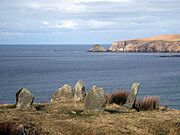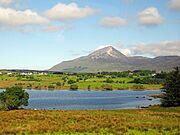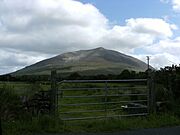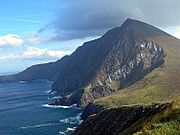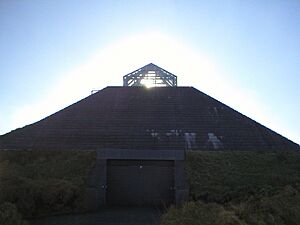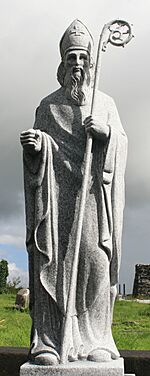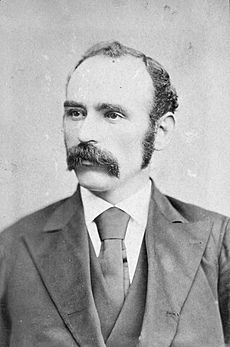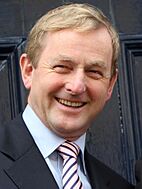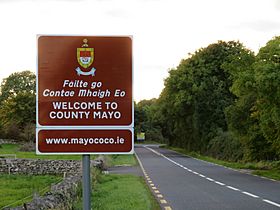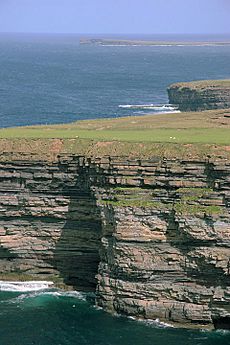County Mayo facts for kids
Quick facts for kids
County Mayo
Contae Mhaigh Eo (Irish)
|
||
|---|---|---|
|
||
| Nickname(s):
The Maritime County, The Yew County (Others)
|
||
| Motto(s): | ||
 |
||
| Country | Ireland | |
| Province | Connacht | |
| Region | Northern and Western | |
| Established | c. 1570 | |
| County town | ||
| Area | ||
| • Total | 5,588 km2 (2,158 sq mi) | |
| Area rank | 3rd | |
| Population
(2022)
|
||
| • Total | 137,231 | |
| • Rank | 18th | |
| • Density | 24.5582/km2 (63.605/sq mi) | |
| Time zone | UTC±0 (WET) | |
| • Summer (DST) | UTC+1 (IST) | |
| Eircode routing keys |
F12, F23, F26, F28, F31, F35 (primarily)
|
|
| Telephone area codes | 093–098 (primarily) | |
| Vehicle index mark code |
MO | |
County Mayo is a beautiful county located in the west of Ireland. It's part of the Connacht province and is named after the small village of Mayo, now known as Mayo Abbey. The local government for the county is Mayo County Council. In 2022, about 137,231 people lived here. The county's borders were set up in 1585, following the old Mac William Íochtar lordship.
Contents
Exploring the Geography of County Mayo
Mayo is bordered by the Atlantic Ocean to the north and west. To the south, it meets County Galway, to the east, County Roscommon, and to the northeast, County Sligo. It's the third largest county in Ireland by land area. It also has a very long coastline, stretching for about 1168 kilometers (726 miles).
There's a big difference between the west and east of Mayo. The west has poor soil and lots of blanket bog, which is a type of peatland. The east, however, has a lot of limestone rock, making the land better for farming.
- The highest point in Mayo is Mweelrea mountain, standing tall at 814 meters (2,671 feet).
- The River Moy in the northeast is famous for salmon fishing.
- Achill Island, Ireland's largest island, is off Mayo's west coast.
- Mayo is home to some of Europe's highest cliffs, like those at Croaghaun on Achill Island. The Benwee Head cliffs drop almost 900 feet (274 meters) straight into the Atlantic!
- The northwest parts of Mayo have amazing natural resources for renewable energy, like strong winds and ocean waves.
- Geography of County Mayo
-
Glengad stone circle, Kilcommon, Erris
-
Nephin, found in central Mayo, is the largest freestanding mountain on the island of Ireland
-
The Cliffs at Croaghaun on Achill Island are the third highest in Europe
Mayo is divided into nine historic areas called baronies. Four are in the north and five in the south:
North Mayo
- Erris (north-west, includes Belmullet, Bangor Erris)
- Burrishoole (west, includes Achill, Newport, County Mayo)
- Gallen (east, includes Foxford)
- Tyrawley (north-east, includes Ballina, Killala)
South Mayo
- Clanmorris (south-east, includes Claremorris, Balla)
- Costello (east-south-east, includes Ballyhaunis)
- Murrisk (south-west, includes Westport, Croagh Patrick)
- Kilmaine (south, includes Ballinrobe, Cong)
- Carra (south, includes Castlebar, Partry)
Biggest Towns in Mayo
Here are the largest towns in County Mayo by population, based on the 2022 census:
- Castlebar (13,054 people)
- Ballina (10,556 people)
- Westport (6,872 people)
- Claremorris (3,857 people)
- Ballinrobe (3,148 people)
- Ballyhaunis (2,773 people)
- Swinford (1,459 people)
- Foxford (1,452 people)
- Kiltimagh (1,232 people)
- Crossmolina (1,134 people)
A Journey Through Mayo's History
Ancient Times in Mayo
People have lived in County Mayo for a very long time! Evidence shows that Mesolithic (Middle Stone Age) communities were here around 4500 BC. There are also many ancient sites from the Neolithic (New Stone Age) period, from about 4,000 BC to 2,500 BC. These include huge stone tombs and stone circles.
The first people in Ireland were hunter-gatherers who arrived about eleven thousand years ago. Later, around 6,000 years ago, people started farming. They grew crops and raised animals. In North Mayo, these early farmers cleared forests. But the soil was thin, and it washed away, leaving behind blanket bog that covered their old fields.
Amazing ancient field systems have been found under the bog, especially along the North Mayo coast at places like the Céide Fields. These show how people farmed thousands of years ago.
The Neolithic people also built large, fancy stone tombs for their leaders. These are called megalithic tombs. There are over 160 of these ancient tombs in County Mayo.
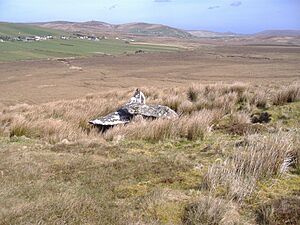
Bronze Age (around 2,500 BC to 500 BC)
During the Bronze Age, people started using metal tools, but still used stone ones too. From this time, we find things like stone circles and fulachta fiadh (ancient cooking sites). People continued to bury their leaders in megalithic tombs, which changed in style.
Iron Age (around 500 BC to AD 325)
The Iron Age began about 2,500 years ago when metalworking became more common. This was also when Celtic-speaking people arrived, bringing the early form of the Irish language. This period was a time of tribal warfare, with different kings fighting for control. Ancient stories like the Ulster Cycle are set in this time.
Early Christian Period (around AD 325 to AD 800)
Christianity came to Ireland around the 5th century AD. This brought new ideas and the Latin alphabet. Saint Patrick is believed to have spent time in County Mayo, even praying on Croagh Patrick mountain for 40 days and nights. Many small monasteries were built across the county, like Mayo Abbey and Cong Abbey.
Around 795 AD, the first Viking raids began. Vikings came from Scandinavia to raid monasteries for their treasures. Some larger monasteries built tall round towers to protect their valuables and show their strength. You can still see round towers at places like Aughagower and Killala.
Anglo-Normans (12th to 16th centuries)
In 1169, the Anglo-Normans from England and Wales invaded Ireland. County Mayo came under their control in 1235. New families like the Burkes, Gibbons, and Walshes settled here. Over time, many of these Norman families became "more Irish than the Irish themselves," adopting the Irish language and customs.
The most powerful family was the Mac William Burkes. They often fought with other families and kings.
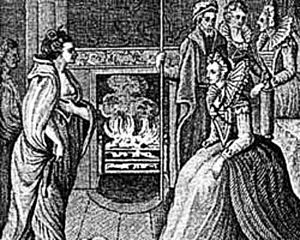
The Anglo-Normans also brought new religious orders to Ireland, who built many large churches and abbeys. Some examples in Mayo include Ballintubber Abbey and Burrishoole Abbey.
During the 15th and 16th centuries, most Irish people remained Catholic, even when the English monarchy became Protestant. Famous figures like Grace O'Malley, the pirate queen, had connections with the English royals. By the late 1500s, the name County Mayo was being used. In 1588, some ships from the Spanish Armada were wrecked off the Mayo coast, and many Spanish sailors who came ashore were captured or killed.
Most of the religious buildings set up by the Anglo-Normans were closed down after the Reformation in the 16th century.
17th and 18th Centuries
Protestant settlers came to Mayo in the early 1600s. Many were killed or forced to leave during the Irish Rebellion of 1641. Between 1641 and 1653, a third of the population was lost due to war, famine, and disease.
Grace O'Malley is a well-known person from Mayo from this time. In the 1640s, when Oliver Cromwell took power in England, Ireland suffered. Many Irish families were forced to move "west of the Shannon River" or leave the country.
The 18th century was a very hard time for most people in County Mayo. Because of the Penal Laws, Catholics couldn't get ahead in society. Some, like William Brown, left Ireland. He left Foxford at age nine and later became an admiral in the Argentine Navy, where he is now a national hero.
In 1798, Mayo was a key part of the United Irishmen Rebellion. A French general named Jean Joseph Amable Humbert landed in Killala with soldiers to help. They marched to Castlebar, surprising the British forces and winning the Battle of Castlebar. Humbert set up a short-lived "Republic of Connacht." However, the French and Irish forces were later defeated by a much larger British army. Many Irish rebels were killed.
19th and 20th Centuries
In the early 1800s, famine was common in Ireland. The population grew very large, and people relied heavily on potatoes. Then, in 1845, a disease destroyed the potato crop, leading to the terrible Irish Famine (1845–47). About a million people died, and another million left the country. Mayo was hit especially hard, as almost 90% of its people depended on potatoes.
You can still see reminders of the Famine in Mayo today, like old workhouse sites and famine graves. Many roads were built as a way to give people work during this time.
In 1879, something special happened in the small village of Knock, County Mayo. Fifteen local people said they saw an apparition of the Blessed Virgin Mary, St. Joseph, and St. John.
A big movement for social change started in Mayo in 1879, led by Michael Davitt and others. They wanted to get land back for the people from landlords and stop unfair evictions. This group became the Irish National Land League.
It was during this time that the word "to boycott" was added to the English language! Charles Boycott was an unpopular English landlord in Mayo. When people refused to work for him or have anything to do with him, this tactic became known as a "boycott." Even though the British government sent soldiers to help him, it cost too much, and the tenants won.
Eventually, the "Land Question" was solved, and farmers were able to buy their land.
A nun from Mayo, Mother Agnes Morrogh-Bernard, started the Foxford Woollen Mill in 1892. It became famous worldwide for its high-quality wool products.
Mayo was also involved in the Irish revolutionary period, including the Irish War of Independence and the Irish Civil War. John MacBride from Westport was part of the 1916 Easter Rising and was executed. His death inspired many in Mayo to fight for independence.
Later, politicians from Mayo continued to play important roles. In 1990, Mary Robinson from Mayo became the first female President of Ireland. She made the role much more important. In 2011, Enda Kenny became the first Taoiseach (head of government) from a Mayo constituency.
Historic Clans and Families
In ancient times, County Mayo was made up of several kingdoms and tribes. Some of these included:
- Fir Domnann – located in Erris
- Gamanraige – ancient kings of Connacht, based in Erris and around Killala Bay
- Uí Fiachrach Muidhe – based around Ballina
- Umaill – a kingdom around Clew Bay, whose rulers became the O'Malley family
People and Population
| Historical population | ||
|---|---|---|
| Year | Pop. | ±% |
| 1580 | 22,080 | — |
| 1585 | 23,920 | +8.3% |
| 1600 | 24,950 | +4.3% |
| 1610 | 25,799 | +3.4% |
| 1653 | 27,211 | +5.5% |
| 1659 | 29,967 | +10.1% |
| 1668 | 38,991 | +30.1% |
| 1672 | 55,202 | +41.6% |
| 1680 | 59,886 | +8.5% |
| 1690 | 63,445 | +5.9% |
| 1700 | 71,224 | +12.3% |
| 1710 | 78,555 | +10.3% |
| 1725 | 90,557 | +15.3% |
| 1781 | 123,207 | +36.1% |
| 1788 | 155,768 | +26.4% |
| 1790 | 195,668 | +25.6% |
| 1801 | 225,799 | +15.4% |
| 1811 | 231,798 | +2.7% |
| 1813 | 267,668 | +15.5% |
| 1816 | 251,334 | −6.1% |
| 1821 | 293,112 | +16.6% |
| 1831 | 366,328 | +25.0% |
| 1841 | 388,887 | +6.2% |
| 1851 | 274,499 | −29.4% |
| 1861 | 254,796 | −7.2% |
| 1871 | 246,030 | −3.4% |
| 1881 | 245,212 | −0.3% |
| 1891 | 219,034 | −10.7% |
| 1901 | 199,166 | −9.1% |
| 1911 | 192,177 | −3.5% |
| 1926 | 172,690 | −10.1% |
| 1936 | 161,349 | −6.6% |
| 1946 | 148,120 | −8.2% |
| 1951 | 141,867 | −4.2% |
| 1956 | 133,052 | −6.2% |
| 1961 | 123,330 | −7.3% |
| 1966 | 115,547 | −6.3% |
| 1971 | 109,525 | −5.2% |
| 1979 | 114,019 | +4.1% |
| 1981 | 114,766 | +0.7% |
| 1986 | 115,184 | +0.4% |
| 1991 | 110,713 | −3.9% |
| 1996 | 111,524 | +0.7% |
| 2002 | 117,446 | +5.3% |
| 2006 | 123,839 | +5.4% |
| 2011 | 130,638 | +5.5% |
| 2016 | 130,507 | −0.1% |
| 2022 | 137,231 | +5.2% |
Mayo was one of the counties most affected by people leaving Ireland in the 19th and 20th centuries. This started with the Great Famine, which caused the population to drop from 388,887 in 1841 to 274,830 in 1851. Many people then left to find work in the United Kingdom and the United States. The population reached a low of 109,525 in 1971. However, as the Irish economy grew in the 1990s and 2000s, more people stayed, and the population of Mayo has increased.
Religion in Mayo
According to the 2006 census, most people in County Mayo are Roman Catholic. There are also smaller numbers of people from the Church of Ireland, Muslims, and other Christian groups.
Irish Language in Mayo
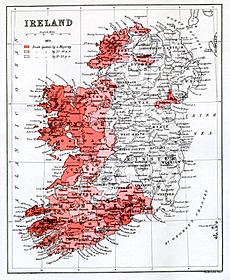
About 9% of people in County Mayo live in a Gaeltacht area. This means it's a region where the Irish language is still spoken every day. Mayo's Gaeltacht is the third largest in Ireland, with over 10,000 people. Tourmakeady is the biggest village in this area, and all schools there teach in Irish. Mayo also has four gaelscoileanna (Irish-speaking primary schools) in its main towns.
Getting Around County Mayo
Train Travel
Westport is the end station for the train service from Dublin. You can also find train stations in Ballyhaunis, Claremorris, Castlebar, Manulla Junction, Ballina, and Foxford. If you're going to Ballina or Foxford, you'll need to change trains at Manulla Junction. There are usually four trains each way every day.
There are also plans to reopen the old Western Railway Corridor that would connect Limerick with Sligo.
Roads
Mayo has several main national roads. The N5 connects Westport to Dublin. The N17 links Mayo with Galway and Sligo. The N26 connects Ballina to Dublin via the N5. There are also many other national secondary roads. A new dual carriageway road is being built from Westport to Castlebar, which will make travel easier.
Air Travel
Ireland West Airport Knock is an international airport located in Mayo. It's named after the nearby village of Knock. The airport has grown a lot, with over 650,000 passengers each year flying to places in the UK and Europe.
Fun Places to Visit in Mayo
- Achill Island
- Ashford Castle
- Ballintubber Abbey
- Blacksod Lighthouse
- Céide Fields (ancient farm fields under bog)
- Clare Island
- Clew Bay
- Cong Abbey
- Croagh Patrick (holy mountain)
- Great Western Greenway (walking and cycling trail)
- Ireland West Airport, Knock
- Knock Shrine (famous pilgrimage site)
- Lough Mask
- National Museum of Ireland – Country Life
- National Famine Memorial
- Nephin (mountain)
- Rockfleet Castle
- Westport House
- Wild Nephin National Park
Media and News in Mayo
Newspapers in County Mayo include The Mayo News, the Connaught Telegraph, and Western People. There's also Mayo Advertiser, which is a free newspaper.
Mayo Now is a monthly magazine about entertainment and culture in the area.
Mayo even has its own online TV channel called Mayo TV, which started in 2011. It shares news and events from around the county. You can also listen to local radio stations like Erris FM and M.W.R. (Mid West Radio).
Energy in Mayo
The Mayo Energy Audit looked at how the county uses and gets its energy. It also explored how Mayo might be affected by changes in fossil fuel supplies and economic challenges. Mayo has great potential for renewable energy sources like wind and ocean power.
Sports in Mayo

The Mayo GAA senior team is famous for Gaelic football. They last won the Sam Maguire Cup (the biggest prize in Gaelic football) in 1951. Since then, they've reached the All-Ireland Final many times, but haven't won it again. Their unofficial fan club is called Mayo Club '51, named after that winning team. Mayo's team colors are green and red.
The most popular soccer teams in the county are Westport United and Castlebar Celtic.
Besides Gaelic football and soccer, other popular sports in Mayo include rugby, basketball, hurling, swimming, and athletics.
Famous People from County Mayo
- Admiral William Brown (1777–1857) – He founded the Argentine Navy and is a national hero in Argentina.
- Michael Davitt (1846–1906) – An important Irish leader who helped farmers get rights to their land. He founded the Irish National Land League.
- Charles Haughey (1925–2006) – Served as Taoiseach (Prime Minister) of Ireland several times.
- Enda Kenny (born 1951) – Was the Taoiseach of Ireland from 2011 to 2017.
- John MacBride (1868–1916) – A military leader who took part in the 1916 Easter Rising.
- Grace O'Malley (around 1530 – around 1603) – A famous pirate queen from the 16th century.
- Mary Robinson (born 1944) – The first female President of Ireland (1990–1997).
- Sally Rooney (born 1991) – A popular author who wrote Normal People.
- Louis Walsh (born 1952) – A well-known entertainment manager and judge on TV shows like The X Factor.
Images for kids
See also
 In Spanish: Condado de Mayo para niños
In Spanish: Condado de Mayo para niños



